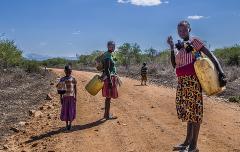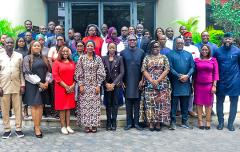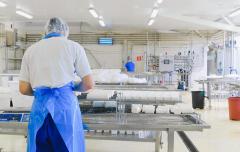Tackling Global Cooling in A Warmer World
There are lots of misnomers about the enormous challenge of delivering cooling services to everyone on the planet as the world gets hotter.
One of the biggest misconceptions is that universal cooling access is largely about everyone wanting an air conditioner. In other words, a luxury or comfort issue. But it’s about much more than that, including life-saving refrigeration for medicine and food. Another mistake is thinking that technological breakthroughs can solve the dual challenge of boosting cooling access to billions who lack it – and do so without adding significantly to climate change pollution.
Where everyone agrees is that cooling is a vastly broad and complex undertaking that the world cannot afford to get wrong. Millions of lives and the stability of the climate are literally at stake.
“When you think of population and income growth, combined with global warming, cooling is perhaps the largest threat we face,” said Iain Campbell, managing director at the Rocky Mountain Institute and a member of a newly-launched Global Panel on Access to Cooling, which met for two days in New York last month. “It’s a huge, huge threat that I don’t think has been fully comprehended.”
The global panel, co-chaired by the President of the Marshall Islands and Natural Resources Minister of the Republic of Rwanda, was launched as part of Sustainable Energy for All’s Cooling for All initiative which aims to provide affordable, sustainable cooling solutions for all.
No doubt, lack of cooling access is an escalating problem for vulnerable populations across the world.
As urban populations grow in regions where extreme heat events are intensifying, cooling is not a luxury good. It is a fundamental component of daily survival – from cold chains for fresh food, to safe storage of life-saving vaccines and medicines, to cooler, safer workplaces that can elevate productivity.
For one billion people globally who lack access to electricity – and therefore, cooling solutions like fans, air conditioners and refrigerators – this is their daunting reality.
On the refrigeration front, consider that 75 percent of food consumed in developed countries is transported through cold chains. In India, it’s only 4 percent, which explains why the country loses up to 40 percent of its fruit and vegetable output every year.
Consider also the ‘heat-island’ predicament of cities. Urban areas, with their vast concrete and asphalt landscapes, are heating up twice as fast as non-urban areas. Cities in the Middle East and Asia experienced scalding 125 degree Fahrenheit temperatures last summer, causing widespread human misery, power outages and other economic harm. For cities experiencing the worst heat-island effects, economic losses could total up to 11 percent of a city’s gross domestic product by the end of the century, according to a study released in May. “We need to re-make cities,” said Kurt Shickman, Executive Director of the Global Cool Cities Alliance, speaking at the Cooling for All panel discussion.
So what will it take to provide urban dwellers and other vulnerable populations with reliable, affordable access to cooling?
Let’s start with the growing demand for air conditioners, fans and other measures for mitigating more extreme heat. As temperatures and income levels rise, energy-guzzling air conditioners, which use 10-20 times more energy than ceiling fans, are flying off the shelves in hot, populous countries such as Brazil, China, India and Indonesia. With AC demand in these countries growing by 10 to 15 percent a year, we’re on a path to have 1.6 billion air conditioners installed globally by 2050 – roughly one for every 6 people on the planet.
This trend is an enormous environmental threat, if we don’t do it in a sustainable and smart way. As more air conditioners come on line, more energy is needed to run them. And if the energy is coming from fossil fuel plants, that means more pollution that will further warm the planet. India alone could see a doubling in air conditioner energy demand in the next 15 years, requiring as many as 300 new power plants to be built, many of them fired by coal.
One of the keys in solving this conundrum is cooling appliances that use less energy. More efficient equipment exists today and far bigger gains can be expected through efforts such as India’s Super-Efficient Air Conditioning initiative launched earlier this year. Another opportunity is a recent international agreement – called the Kigali Amendment, as part of the Montreal Protocol – which requires the phase-down of high-polluting refrigerants commonly used in ACs and other cooling equipment. Phasing down hydrofluorocarbons (HFCs), combined with energy efficiency gains in cooling equipment, could avid as much as 1 degree Celsius of global warming.
Common-sense measures can also mitigate extreme heat, especially in urban areas. A growing number of cities, including New York City and Dubai, are using low-tech cooling strategies such as vegetation cover, white-covered ‘cool’ roofs and smarter street and building design requirements that promote air ventilation and shade. New York City is explicitly targeting these efforts at poorer neighborhoods that are especially vulnerable to extreme heat events.
Another big opportunity is developing cold chains for food and medical supplies. Globally, an estimated 1.3 billion tons of food, representing a third of total food production for human consumption, is lost or wasted every year due to the absence of proper cooling. The lack of continuous cold chains also prevents effective distribution and access to medical supplies and vaccines, resulting in an estimated two million unnecessary deaths every year.
Dozens of high-tech and low-tech cooling technologies – with catchy names like the Solar Polar Cooler, Cool Pushcart and the Magic Fridge – are popping up in Africa, Asia and elsewhere to help preserve food and vaccines.
While many of the technologies work remarkably well, their growth potential remains unclear due to the fragmented nature of cold chains in many countries. Consider the case of India, where a growing number of rural farmers are using new cold storage technologies, but they are still unable to get their products to commercial markets due to the lack of refrigerated transport vehicles.
“It’s critical that we look at the entire cold supply system, not just individual technologies,” said Toby Peters, Professor in Cold Economy, at the University of Birmingham in England, speaking at last month’s cooling panel.
Peters says it is also important to evaluate cooling solutions through the prism of value creation. By having a holistic, integrated cold supply chain in India, for example, farmers can earn far more money by being able to sell their crops in markets that are long distances from their farms. “It’s not cooling for the sake of cooling, it’s cooling for the sake of creating value, societal benefits,” he said.
SEforALL note: This story originally appeared in Refrigeration and Air Conditioning News (RAC) and can be found here



